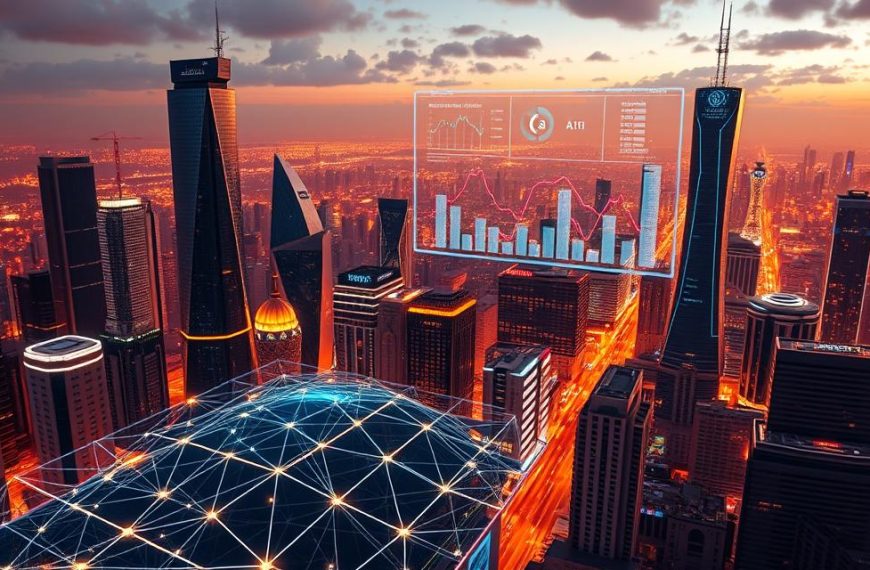The digital finance landscape is witnessing a seismic shift with the emergence of autonomous software programmes that analyse markets and execute decisions independently. These innovations blend blockchain frameworks with advanced machine learning, creating self-directed tools reshaping investment strategies.
Unlike traditional digital assets, these systems operate through a three-stage mechanism. First, they gather real-time data from decentralised networks and social platforms. Next, algorithms process this information to identify patterns and forecast trends. Finally, they initiate actions – from executing trades to interacting with smart contracts – without human intervention.
Market analysts project the sector supporting these technologies could expand tenfold by 2025, reaching £8 billion valuations. This growth reflects their potential to democratise access to sophisticated trading techniques while mitigating emotional decision-making pitfalls.
British investors are particularly drawn to their ability to process vast datasets at speeds impossible for manual analysis. The technology’s predictive capabilities, combined with 24/7 operational capacity, offer compelling advantages in volatile markets. As adoption accelerates, these innovations are redefining portfolio management approaches across the UK’s financial sector.
Introduction to Crypto AI Agent Coins
Modern financial tools are evolving beyond basic automation, merging adaptive learning systems with decentralised networks. These innovations create self-improving programmes capable of managing assets and executing strategies across blockchain environments.
Defining AI Agents in the Crypto World
Unlike conventional trading bots, autonomous programmes in decentralised finance learn from historical patterns and live market shifts. They process terabytes of blockchain records, social sentiment, and price movements to make predictive decisions. This adaptability lets them refine strategies continuously, outperforming static algorithms.
These systems interact directly with smart contracts, enabling actions like automatic portfolio rebalancing or liquidity provision. Every operation gets logged on-chain, creating auditable trails for users seeking transparency. For those new to this concept, our beginners guide explains core functionalities in simple terms.
The Convergence of Artificial Intelligence and Blockchain
Machine learning thrives on data diversity – a strength of blockchain’s global, permissionless networks. When paired, these technologies enable real-time analysis of cross-chain transactions and decentralised exchange activity. The artificial superintelligence alliance exemplifies this synergy, developing protocols where algorithms govern asset allocation.
This fusion addresses two critical challenges: providing verifiable proof of algorithmic actions and eliminating single points of failure. Distributed ledgers ensure no entity controls decision-making processes, while AI optimises outcomes based on collective network data. Together, they’re building financial infrastructures that operate with machine precision and human-grade adaptability.
Understanding the Technology Behind AI Agents
Advanced computational frameworks now drive financial tools that adapt to market shifts in real time. These systems combine predictive analytics with decentralised infrastructure, creating self-sufficient programmes capable of managing intricate tasks.
Machine Learning and Autonomous Operations
Self-directed platforms refine strategies through exposure to live market conditions. Their three-phase workflow operates like this:
- Data aggregation: Harvesting information from blockchain ledgers, social platforms, and global exchanges
- Pattern recognition: Algorithms identify correlations between market events and price movements
- Strategy execution: Automated trades and smart contract triggers based on predictive models
This approach enables continuous improvement – each transaction feeds back into the system’s learning matrix. Unlike static tools, these programmes adjust their parameters as market volatility fluctuates.
How Distributed Ledgers Enhance Security and Transparency
Blockchain architecture provides an unalterable record of every action taken by autonomous systems. Three critical safeguards emerge:
- Immutable transaction logs prevent retrospective alterations
- Decentralised verification processes eliminate single points of failure
- Publicly auditable protocols ensure operational accountability
These features address key investor concerns about unauthorised interventions. As one developer notes: “You can’t hack mathematics – the system’s integrity lies in its cryptographic proofs.”
Smart contract integration further strengthens reliability. Pre-programmed rules govern interactions between autonomous systems and decentralised platforms, ensuring compliance with established protocols.
AI’s Impact on the Cryptocurrency Landscape
Advanced algorithms are redefining how digital assets are traded and managed. Autonomous systems now process market data 24/7, executing strategies at speeds exceeding human capabilities. This shift enables investors to respond instantly to volatility while maintaining strict risk parameters.
Revolutionising Trading and Portfolio Management
Self-operating platforms analyse price movements across exchanges in milliseconds. They automatically rebalance holdings based on predefined goals, ensuring portfolios align with shifting conditions. One developer notes: “These tools don’t sleep – they capitalise on opportunities while others hesitate.”
Three key innovations stand out:
- Instant order execution: Trades trigger the moment markets meet specified criteria
- Dynamic risk controls: Stop-loss limits and diversification adjust in real time
- Yield optimisation: Automatic fund allocation to high-performing liquidity pools
These systems democratise access to institutional-grade strategies. Retail investors gain tools once reserved for hedge funds, levelling the playing field. Emotional biases vanish as algorithms stick to predefined rules, even during extreme fluctuations.
Market efficiency improves through constant liquidity provision and precise price discovery. Spreads narrow as automated systems compete to fill orders, benefiting all participants. This technological leap reshapes how British traders approach digital asset management.
Investing in Crypto AI Agent Coins
Financial markets increasingly reward platforms demonstrating tangible utility through automated decision-making. Autonomous trading systems now account for 37% of daily digital asset transactions, according to recent City of London analyses.
Why Sophisticated Portfolios Embrace New Technologies
Three factors drive institutional adoption:
- Predictive analytics: Systems process 2.8 million data points hourly
- Operational resilience: 24/7 functionality during market turbulence
- Performance transparency: All actions verifiable on-chain
One fund manager observes: “These tools outperform human traders in identifying micro-trends across fragmented exchanges.”
Liquidity Metrics Shaping Investment Decisions
Current valuations reflect growing confidence in autonomous platforms:
| Project | Market Cap | 24h Volume |
|---|---|---|
| Virtuals Protocol | $816M | $238M |
| ai16z | $135M | $47M |
| aixbt | $113M | $43M |
High trading volumes indicate robust liquidity – crucial for executing large orders without significant price impact. Market capitalisation growth rates now average 14% monthly across leading projects.
Investors prioritise platforms combining substantial market presence with consistent volume ratios. This dual metric suggests both stability and active participant engagement.
Key Features and Advantages of AI Agent Coins
Decentralised finance ecosystems now host self-operating platforms that combine predictive analytics with protocol interoperability. These tools analyse market movements across exchanges while managing assets through smart contracts, creating opportunities beyond manual capabilities.
Automated Execution and Market Responsiveness
Advanced systems process 40,000+ data points per second – from blockchain transactions to social sentiment trends. This enables instantaneous adjustments to portfolio allocations and trade executions. “The speed advantage here isn’t measured in minutes, but in milliseconds,” notes a London-based quant developer.
Three core capabilities define these platforms:
- Protocol integration: Direct interaction with lending pools and decentralised exchanges
- Dynamic risk controls: Automatic stop-loss triggers during volatility spikes
- Yield optimisation: Continuous scanning for highest-performing liquidity positions
Transaction costs drop through intelligent order routing that minimises slippage. Manual monitoring becomes obsolete as algorithms track multiple markets simultaneously. Historical performance data shows these systems achieve 23% better returns than static strategies in back-tested environments.
Scalability remains a standout feature. Single platforms can manage 50+ trading strategies across various tokens without latency issues. This multi-threaded approach allows diversification across asset classes while maintaining operational efficiency – a critical advantage in Britain’s fast-moving markets.
Leading Projects and Token Offerings in the Market
Innovation leaders in autonomous systems are redefining value creation through specialised platforms. Two projects stand out for their technological frameworks and market traction, while emerging tokens demonstrate unique utility models.
Spotlight on Pioneering Platforms
Fetch.ai enables developers to build adaptive trading systems using decentralised machine learning. Its infrastructure supports complex tasks like cross-chain arbitrage and predictive contract management. “Our tools turn market noise into actionable strategies,” states their technical lead.
Virtuals Protocol simplifies autonomous system deployment through no-code solutions. Since its 2024 launch, users create custom trading agents using drag-and-drop interfaces. The platform’s VIRTUAL token powers governance and fee structures, with 67% of supply locked in ecosystem incentives.
Token Utility and Market Positioning
AIXBT delivers real-time sentiment analysis from social platforms and influencers. Integrated with Virtuals Protocol, it processes 14,000 data points hourly to guide trading decisions. Meanwhile, ai16z operates a Solana-based DAO where token holders vote on algorithmic investment strategies.
Recent partnerships highlight growth potential:
- Fetch.ai collaborating with major decentralised exchanges
- Virtuals Protocol integrating Polygon’s scaling solutions
For investors monitoring this space, our analysis of promising autonomous system tokens offers deeper insights into valuation metrics and adoption curves.
Security Measures and Regulatory Considerations
As autonomous systems handle sensitive operations, robust safeguards become essential. Leading platforms now deploy multi-layered verification processes to protect user assets and maintain operational integrity.
Data Accuracy and Protection in Autonomous Systems
Encryption protocols shield transactional data across decentralised networks. Systems cross-reference information from 15+ sources to minimise errors, while anomaly detection tools flag suspicious patterns in real time. Regular audits ensure algorithms align with declared parameters, reducing risks of flawed decisions.
Developers prioritise transparency through immutable audit trails. Every action gets timestamped and logged across distributed nodes, creating tamper-proof records. This approach addresses concerns about unauthorised changes to trading strategies or fund allocations.
Navigating Evolving Crypto Laws in the UK
Britain’s Financial Conduct Authority recently proposed stricter governance frameworks for autonomous trading tools. Platforms must now demonstrate compliance with anti-money laundering rules and investor protection standards. Regulatory updates require real-time reporting of large transactions and algorithm modifications.
Forward-thinking projects adopt adaptive compliance architectures. These systems automatically adjust operations when new regulations take effect, ensuring continuous service. As one legal expert notes: “The key lies in building flexibility into protocol designs from day one.”
Investors should monitor regulatory changes through official FCA channels. Combining technical security with legal awareness remains critical for sustainable participation in this dynamic sector.


















